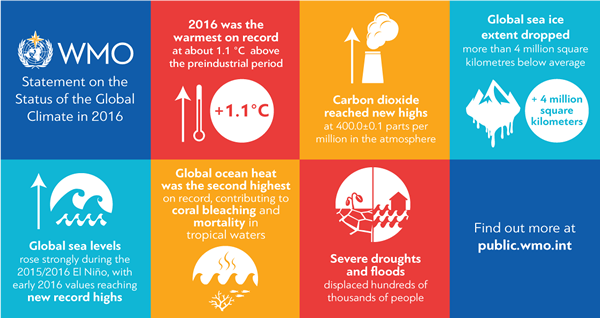

WMO release State of Global Climate in 2016 report - multiple records broken
The WMO have today released their State of Global Climate in 2016 report, detailing a record global temperature, exceptionally low sea ice, continued sea level rise and increasing ocean temperatures, with extreme weather and climate continuing into 2017.
The authoritative annual statement is based on several international datasets maintained independently by global climate analysis centres, as well as research institutes and national meteorological and hydrological centres.
The report confirms that 2016 was the warmest on record – 1.1°C above the pre-industrial period and 0.05°C above the previous record set in 2015. Furthermore, each of the 16 years since 2001 has been at least 0.4°C above the long-term average for the 1961-1990 base period, used by WMO as a reference for climate change monitoring.
The combinations of powerful computers and long-term climate data enable scientists to demonstrate the links with long-term climate change caused by greenhouse gas emissions. Carbon dioxide levels in the atmosphere reached the symbolic benchmark of 400 parts per million in 2015 and will not fall below that level for many generations due to the long-lasting nature of carbon dioxide. The powerful 2015/2016 El Niño event boosted global temperatures in 2016, with temperatures in strong El Niño years typically 0.1°C to 0.2°C warmer than background levels.
“Globally averaged sea surface temperatures were also the warmest on record, global sea levels continued to rise, and Arctic sea-ice extent was well below average for most of the year. With levels of carbon dioxide in the atmosphere consistently breaking new records, the influence of human activities on the climate system has become more and more evident,” said WMO Secretary-General Petteri Taalas.




